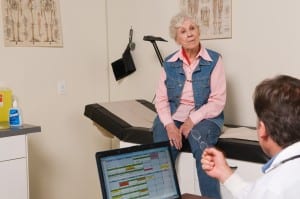Thre are major changes looming in the nursing field across Canada. From the recent push for hospitals to convert to a universal medical records system to the implementation of new patient to nurse communication devices – the revolution is coming full throttle.
“There’s so much technology that is being developed for the healthcare system right now, and it is being developed at such a fast rate,” said Johanne Mattie, research associate at MAKE+ at BCIT. “And there’s been a lot of resistance from the health care professionals in terms of adoption.”
For the past four years, Mattie and her colleagues at TPEG have been monitoring and researching these developments. The group has been funded by NRC-IRAP, a government funded organization that aims to help small businesses succeed. The main goal of the entire NRC-IRAP/TPEG partnership was to assist vendors who are developing e-health products and help them improve the usability of those products by better understanding what the strengths and weaknesses are. TPEG has been testing those products under simulated real life conditions and observing how receptive the patients or nurses are to the new technology.
There were three separate projects under the current phase of this initiative. The first initiative, which started in the summer of 2009, involved implementing an electronic charting system inside the School of Health Science’s nursing Simulation Lab. Prior to this project, all the charting was done on paper. The lab is modeled after a real emergency acute care ward and is equip with simulators, where nursing students could go in and practice techniques. Together with local vendor software MDIT and BCIT Nursing faculty, TPEG set up an electronic charting system with multiple computers in the lab for students to try. Students were also able to provide feedback to MDIT to help them improve their system.
The second project in the initiative involved investigating the potential for using mobile devices in nursing. On the touch screen devices, nurses can download textbooks as well as special apps designed to acquire instant information. TPEG worked with BCIT Nursing faculty and students to better understand benefits and barriers to using this technology.
The final project centered around evaluating a remote patient monitoring system created by Virtual Health Care Solutions. The company developed a tablet computer that would allow patients with chronic illnesses to communicate with their health care professional without having to leave their house. On top of the video conferencing feature, the tablet has the capability to capture a patient’s glucose and blood pressure and directly send the results to a nurse. That same tablet can control the lights, room temperature as well as security features like surveillance cameras.
“It’s great technology,” said Mattie. “But the question was: if you’re a 90-year-old and you’ve never used a computer, is this something you’re going to want to do or something you are comfortable with?”
Mattie and colleagues tested out the technology inside the Dr. Tong Louie Living Lab.
“We set it up like a living room and we invited seniors with chronic illnesses to come,” Mattie said. “Some had never touched a mouse before and we were able to show them how to do a remote call to a nurse.”
NRC-IRAP, has spent an estimated $225,000 funding the initiative over the past four years. That investment has proven to be money well spent. Through projects such as those described above, Mattie and her team were able to test products in realistic settings through the Living Lab, Simulation Lab, and nursing classrooms. And by taking advantage of TPEG’s rolodex full on contacts and connections within the health industry, they were able to gather extensive feedback from the end users of the technologies. These findings have been shared with the wider ehealth vendor community to help them better understand how to make their products more user-friendly for consumers.
“I think we identified other opportunities for these companies,” Mattie said. “We’re trying to help them bring their products to commercialization.”
BCIT also benefitted from the projects. Over 200 nursing students have participated in the study and were able to gain hands-on experience with cutting edge technologies within their field.
“I think the pilot with the charting system certainly gave the nursing school momentum to want to carry on with this kind of thing,” said Mattie. “We realize that we have to do these of projects at BCIT, we have to be leading edge and one step ahead.”

badly needed! keep up the good work!